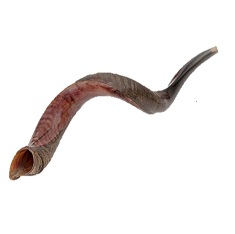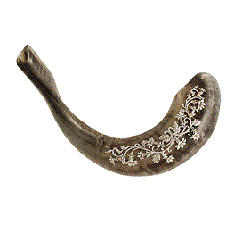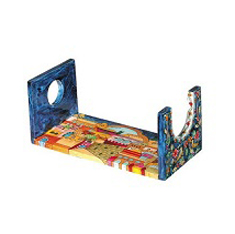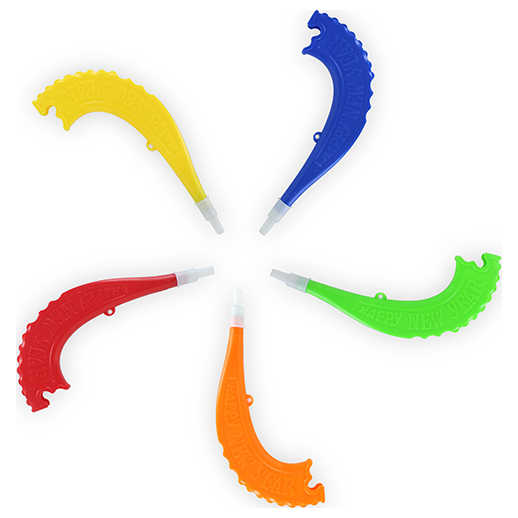Shofars - Everything You Need to Know
WHAT IS A SHOFAR?
A shofar is a ritual and traditional musical instrument. Made from a ram’s horn or a Kudu’s horn, the shofar is sounded multiple times on Rosh Hashanah (the Jewish New Year) and at the end of Yom Kippur (the Jewish Day of Repentance). The Shofar is also blown throughout the Hebrew month of Elul, the period leading up to Rosh Hashanah.
WHAT DOES THE BLOWING OF THE SHOFAR MEAN?
The shofar has many roles; it leads to repentance for sins of the previous year, and reminds the faithful of the travails of the Jews over time. It also harkens us back to biblical and ancient times.
The shofar is a symbol of the binding of Isaac and the ram that God provided as a sacrifice in Isaac’s place.
The shofar blast was heard when the Israelites received the Ten Commandments. Its cries are meant to remind us of the cries and tears shed for the destruction of the Holy Temple in Jerusalem. In addition, the shofar blast will signal the return of the Jewish people when Mashiach (the Messiah) comes. When we blow the shofar today, it is therefore meant to remind us of God’s salvation in our own lives.
In ancient times, the shofar was sounded to announce war, declare victory, and on the coronation of kings.
WHY IS THE SHOFAR BLOWN ON ROSH HASHANAH?
Rosh Hashanah is the Jewish New Year and the day on which God is said to have created the world. The shofar is a reminder for us to do teshuva (repentance) so that we can start our new year in the best way possible.
ARE THERE DIFFERENT TYPES OF SHOFARS?
Shofars (or shofarot in Hebrew) come in a variety of shapes, sizes, and lengths. You can purchase a polished shofar - easier to clean - or an all-natural one. Of course, Judaica.com carries a selection of half-polished/half-natural shofars, too.
There are three types of traditional shofars: Ram’s horn, Moroccan ram’s horn, and Yemenite kudu horn shofars.
Some people prefer to purchase decorated ram’s horns, with silver plating, paint, or other adornments. That’s because outside of their use on Rosh Hashana, shofars make excellent home decorations, especially on a shofar stand.
DIFFERENT TYPES OF SHOFARS
The ram’s horn shofar is the most classic shofar. Ram’s horn shofars are generally dark brown and half-polished, but they can be fully polished, hand-painted, or even adorned in silver.
Yemenite shofars are traditionally made of a kudu’s horn and have long and curvy bodies. The kudu is an African antelope. Yemenite shofars, like ram’s horn shofars, come in a variety of styles - polished and unpolished, decorated and in simple, traditional brown tones - and produce a strong, brass sound.
Moroccan shofars, like most classic Ashkenazi shofars, are made of a ram’s horn. However, they tend to be made of horns that are flat, with a single, broad curve.
Decorative Shofars
Shofars are not only musical instruments, but they are also art. Judaica.com offers an exquisite collection of decorative shofars, included silver-plated and hand-painted varieties. Some of the shofars are adorned with images of the holy city of Jerusalem, for example.
Types of Shofar Finishes
Shofars are made of animals’ horns. Therefore, before they can be used, they need to be processed and polished. There are different types of polished shofar finishes, all of which are available at Judaica.com:
- Polished: a fully polished shofar with a very high gloss.
- Half-polished: a partially unpolished shofar, in order to display the natural look of the horn.
- Natural: a clean and sterilized but unpolished shofar.
Toy Shofars
Blowing the shofar is such an important part of Rosh Hashanah, why not let the kids participate in the tradition with a toy shofar! Judaica.com has a few varieties:
- Our colorful toy shofar that come in a variety of neon colors. Made of plastic, these toy shofars toot when blown.
- Judaica.com also carries a kids shofar that is made of plastic but looks extremely realistic in marbled amber brown and marbled gold cream.
- A third option is a realistic looking non-marbled plastic shofar. We have realistic toy versions of both the ram’s horn and yemenite shofar.
OTHER THINGS TO CONSIDER WHEN YOU BUY A SHOFAR
Every Shofar is Unique
Shofars are hand-made from ram or kudu horns. As such, it is natural that each one will vary slightly from each other and the image.
Shofar Accessories
Something to consider purchasing in addition to a shofar would be a shofar stand or bag. We offer shofar stands that are going to range from a practical piece to a unique piece of art and a statement item. We have ones that are acrylic, wood and metal. Our shofar bags make carrying much easier and are a great way to keep your shofar from scratching.
Kosher-certified
Although technically a shofar is a specific type of musical instrument and any horn manufactured in a way that meets the halachic definition of a shofar can be used to perform the mitzvah, Judaica.com only sells the most authentic and kosher shofars.
We specialize in shofars made at the BarSheshet-Ribak Shofar factories, known as Shofarot Israel. The Ribaks have been manufacturing thousands of shofars a year in the very same building in Tel Aviv since the Ribaks emigrated from Poland in 1927. The BarSheshet family of shofar producers emigrated from Morocco in 1947 and started a factory in Haifa. By the 1980s, the two families went from being competitors in the shofar business to partners. They make the best shofars on the market.
SHOFARS MAKE EXCELLENT GIFTS
Many Jews not only use shofars in synagogue but purchase them as ornamental art. As such, they make wonderful gifts for all occasions - bar or bat mitzvahs, weddings or housewarming. This is especially true when the shofar an embellished or plated shofar is purchased, or you include a decorative stand.
Please note: Judaica.com offers wholesale pricing for shofars that are purchased in bulk. Please contact us for details.
HOW TO CARE FOR YOUR SHOFAR
How do you clean a shofar?
Removing the odor from a shofar is easier than you think. Among the possible options are a white vinegar and water rinse: Plug the mouthpiece of the shofar and pour one-part white vinegar with three parts warm water into the shofar. Let it sit for 24-48 hours. Then, pour out the vinegar and let the shofar dry naturally. Other options are using rubbing alcohol or enzyme cleaner instead of the vinegar and water.
How do you polish a shofar?
To maintain the beauty of your shofar, a microcrystalline wax polish can be used periodically.
LEARN TO BLOW THE SHOFAR
Judaica.com’s “Teka BeShofar: Mastering Shofar Blowing” easy-to-use, informative and innovative shofar-blowing guide can help you.
The guide is a step-by-step manual that will walk you through everything from selecting the right shofar, to good posture and breathing, to perfecting each distinctive shofar sound.
This shofar guide includes pictures and a description of relevant halachos (Jewish laws), minhagim (traditions), and advice from expert shofar blowers.
LEARN THE BLESSINGS YOU SAY OVER THE SHOFAR
We say two blessings before blowing the shofar:
Baruch ata Hashem Elokeinu melekh ha-olam asher kidshanu b’mitzvotav v’tzivanu lishmoa kol shofar.
Blessed are You, Ruler of the World, who has made us holy with commandments, and who has commanded us to hear the voice of the shofar.
Baruch ata Hashem Elokeinu melekh ha-olam shehecheyanu v’kiyimanu v’higiyanu lazman ha-zeh.
Blessed are You, Ruler of the World, for giving us life, for sustaining us, and for enabling us to reach this season.
 Get expert help from team members like Azik
Get expert help from team members like Azik





























